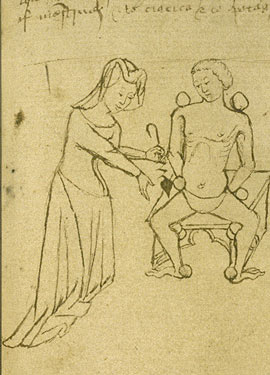Dorotea Bucca facts for kids
Dorotea Bocchi (born in 1360, died in 1436), sometimes called Dorotea Bucca, was an Italian noblewoman who became famous for studying medicine and philosophy. She was connected to the University of Bologna, one of the oldest universities in the world. People aren't entirely sure if she taught there or just held a position, but everyone agrees she was very active at the university for over 40 years, starting in 1390.
Contents
Dorotea's Family and Her Path
Dorotea's father, Giovanni di Bocchino Bocchi, was a Professor of Medicine at the University of Bologna. Records show that Dorotea was one of his children. Her mother was Ghisia da Saliceto. Dorotea was married twice, first to Bartolomeo Carlini and later to Giacomo Paltroni.
Following in Her Father's Footsteps
Many years after Dorotea, in 1596, a scholar named Francesco Serdonati praised both Dorotea and her father. He noted Giovanni Bocchi's time at the university and Dorotea's great skills in reading and speaking. Serdonati also mentioned that both Dorotea and her father earned good money from their academic work.
Later, in 1620, another writer, Francesco Agostino Della Chiesa, wrote that Dorotea started teaching in 1419. A librarian from Bologna, Ludovico Maria Montefani Caprara, also said that Dorotea began teaching philosophy in 1420. These facts suggest that Dorotea followed her father's career path. Some experts, like Professor Monique Frize, believe Dorotea became a professor of both philosophy and medicine, just like her father.
Was Dorotea a Professor?
There are different ideas about what Dorotea studied and taught. Serdonati thought she only studied philosophy. However, other historians like Caroline P. Murphy, Leigh Whaley, and Gabriella Berti Logan believe she studied medicine. Professor Monique Frize says Dorotea studied both. It was quite common back then for professors at the University of Bologna to study both medicine and philosophy.
However, one Italian historian, Tommaso Duranti, wonders if Dorotea Bocchi was a real person at all. He thinks she might have been made up to make the university and certain families seem more important. But many other scholars, including Caroline P. Murphy, Leigh Whaley, Gabriella Berti Logan, and Dr. Monique Frize, believe Dorotea was a real historical figure.
Art Inspired by Dorotea
In 1606, a writer named Pablo de Ribera included Dorotea in a collection of portraits called Le Glorie Immortali (The Immortal Glories). This book showed pictures of amazing women. Later, between 1680 and 1690, a sculptor created a statue of Dorotea as part of a group of famous women from Bologna. This statue gives us an idea of what Dorotea might have looked like.
Other Amazing Women in History
Before the 1800s, Italy was more open to women studying medicine compared to England. Many Italian women actively worked and contributed to medicine. Some examples include Anna Morandi Manzolini, who was a Professor of Anatomy at the University of Bologna in 1760, and Trotula of Salerno from the 11th century. Other notable women were Abella, Jacobina Félicie, Alessandra Giliani, Rebecca de Guarna, Margarita, Mercuriade (14th century), Constance Calenda, Clarice di Durisio (15th century), Constanza, Maria Incarnata, and Thomasia de Mattio.
When it comes to Dorotea, some people believe she was the very first woman to teach at the University of Bologna, paving the way for other women. However, other scholars think that Laura Bassi was actually the first woman to hold a teaching position there.
See also
 In Spanish: Dorotea Bucca para niños
In Spanish: Dorotea Bucca para niños


